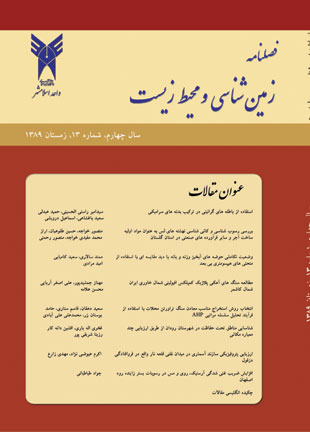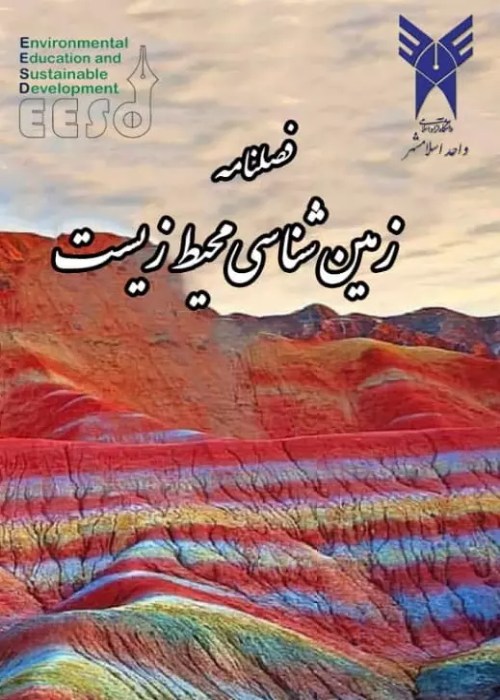فهرست مطالب

نشریه زمین شناسی محیط زیست
پیاپی 13 (زمستان 1389)
- تاریخ انتشار: 1389/10/11
- تعداد عناوین: 8
-
Page 1Granite process industries generate a large amount of wastes, which pollute and damage the environment. This work aims to characterize and evaluate the possibilities of using the granite sawing wastes in ceramic industry. Granite wastes in the form of sludge, obtained from granite cutting industry. Their characterization was carried out with the determination of physical and chemical composition by DTA, TGA, and XRD. Then they wereincorporated in the batch formulations of porcelain tiles in order to evaluate the suitability of addition of wastes in ceramic compositions. The specimens were also tested to determine the water absorption and three pointsbending flexural strength. Microstructural evaluation was carried out by scanningelectron microscopy. The results showed that reformulated ceramic bodies had technological characteristics similar to those of conventional granite tiles. The amount of the granite waste contribution in the laboratory and manufactory scales was 30 and 4-8 wt.%, respectively.Keywords: Environment, Granite tiles, Sludge, Granite stone
-
Page 13In recent years, many industries activities such as refining crude oil, aluminum and zinc production, ship repair and construction, loading and unloading of minerals and chemicals, etc. As a development center in Bandar Abbas, southern Iran, which formed the subject exacerbate pollution load destruction of sensitive ecosystems coastal waters region. Therefore, measures to identify and measure heavy metals and trace elements with regard to harmful effects on marine ecosystems including aquatic and consequently affects puts man in sediments of coastal waters is an important. Based on this in this study the amount of heavy metals Zn, Cr, Ni and Cd insediments in coastal areas target Bandar Abbas apparatus flame atomic absorptionspectroscopy (AAS) was measured. All stages of sample and digestion of sediment according to standard methods (MOOPAM) were. Thus, the average concentration of heavy metals Zn, Cr, Ni and Cd in sediments, respectively 89.1 ± 0.3, 90.4 ± 0.3, 27.9 ± 0.3 and 2.1 ± 0.2 (μg g-1) dry weight sediment, respectively. This value with an average concentration of elements in sediments above and other global internal and external areas were analyzed and compared. Statistical analysis (ANOVA: Single Factor) showed that the average concentration of heavy metals Zn, Cr, Ni and Cd in sediment are significant differences between the crossings. Two elements Cd and Zn with a correlation coefficient of 0.7651 have the highest correlation and then the order of elements Ni and Cr with the coefficient correlation 0.7410, Cd and Cr with the coefficient correlation 0.599, Zn and Cr coefficient correlation 0.5603 and Ni and Zn with the coefficient correlation 0.1704 are. With coefficient significant and positive correlation between Cd and Zn, Cd and Cr, Zn and Cr and finally be determined that the source of pollution in the sediments of these elements is the same. The results show there are no statistically significant correlations for Cd, Ni coefficient.Keywords: loess sediments, Brick, Silica, Alumina, Golestan Province
-
Page 27The physical attributes of Basins have great effects on the process of erosion. Among the most important parameters of basins that directly or indirectly have great effects on the erosion. For example the elevation of basin indicates its climatic condition and it is effective in raining and considering the face that each rainfall has its own hydrology it has special role in erosion. Therefore in order to analyze the condition of erosion and sedimentation with a comparative view in the basins of Vazne and Bane, undimensional hepsometric tables and curves have been designed.It becomes clear that in the Vazne basin the development of plain and elevation is tosome extent balanced. The low space between two curves is indicative of the approachof the basin to equilibrium. in contrast in Bane basin considering the condition of the curves it becomes clear that tis Basin is more away from that equilibrium and is younger and less development.Keywords: Bane basin, Vazne basin, Erosion, dimensionless hypsometric curves
-
Page 37In this study, one outcrop of ophiolitic complex of pelagic limestone in North of Kashmar (a part of Sabzevar ophiolitic) was examined which was placed in 65 kilometers in North of Kashmar near Khazarbeig village, Its thickness is about 85 meters. According to done studies on microscopic thin sections that taken from this limestone section, we determined its age is Middle Campanian to Upper Maastrichtian. The fossils generally consist of families Foraminifera, Globotruncanidae, Globigerinidae, Hedbergelidae and Heterohelisidae. According to Biozonation (Caron, 1985), in this limestone we have 7 Biozones, G. levate, G. ventricosa, G. calcarata, G. havanesis, G. aegyptiaca, G. gansseri, A. mayaroensis. Furthermore, the name of this limestone in this section according to Dunham(1962) is Bioclastic wackestone and Bioclastic packstone. Considering this studies, the facies of this limestone, according to Wilson model (1975), is FZ1 and standard Microfacies according to Flugel(2004) is SMF3. The result of this study is that the sedimentary environment of this carbonate section is Deep Sea (Deep Sea and Cratonic deep- water basin) with pelagic faciesKeywords: In this study, one outcrop of ophiolitic complex of pelagic limestone in North of Kashmar (a part of Sabzevar
-
Page 49Nowadays various methods such as wire saw, chain saw and water jet can be used to extract dimensional stones. These methods have some advantages and disadvantages in respect to different criterion such as technical, economical, geological, and environmental and etc. Therefore, choosing a suitable method in stone mine extraction to achieve more efficiency considering technical and environmental aspects is necessary. In this paper for selection suitable extraction method for travertine mines in Mahallat, analytical Hierarchy Process (AHP) and Expert Choice software is used. For this purpose, eight criteria including geological aspect, environmental aspect, extraction time, cost, safety, cutting quality, application facility and performance method and three extraction alternative including wire saw, chain saw and water jet have been taken into account. Regarding to results of AHP analyze the chainsaw method with priority of 0.471 is the best mining extraction method for quarry mines in Mahallat. The results show that replacement of chainsaw method instead of usual method (wire saw) caused to improvement of technical, economical, geological and environmental conditions of travertine mines of Mahallat.Keywords: AHP, wire saw, chainsaw, water jet, travertine mines of Mahallat
-
Page 65Roodan Township has many habitats and extensive varieties of protected species in Hormozgan province. It needs to study and practically to make efforts for protection of wildlife.The goals of this study include recognition the criterias of protection,the regular gradation and specified coefficients of criterias and introduction of criterias protection. It extracted 5 original criterias and 27 subcriterias criterias and subcriterias sifted by Delphi method and, finally, 5 original criterias and 24 subcriterias they elected as selection of protected regions.They separately introduced to assess proper protection places by analyzing about prioritized and regular gradation and specified coefficients in math method. It is presented, the indexes that change to plans and suit characteristics of according to studies what is researched, for all elected subcriterias.Then plans enter GIS (Geographic Information system) environment. Finally, elected item recognized to protect by entering prepared math model in Roodan Township.Keywords: Protected Areas, Protection Criteria, Analytical Hierarchy Process, Delphi Method, Roodan ownship
-
Page 79Galenar oilfield is located in 40 kilometers to the north of Andimeshk and have two Reservoir with names of Asmari formation and Bangestan group.Asmari formation with composition of Limestone, Sandstone, Sandy limestone with shale layers is one of the important hydrocarbon reservoir in Dezful Embayment therefore in this paper petrophysical evaluation in Asmari formation is studied with use of Geolog software that including of lithology, shale volume, porosity and water saturation. Accordingly the appropriate zones with good economical exploration are identified. Based on eva1uation Asmari formation has three reservoir zones. The mean porosity in A1 zone is 2%,the mean water saturation is 55% and the mean shale volume is 7.5%.the mean porosity in A2 zone is 12%,the mean water saturation is 45% and the mean shale volume is 37.5%,the mean porosity in A3 zone is 5%,the mean water saturation is 40% and the shale volume is 35%.with comparison of other oilfields in Dezful Embayment, porosity and water saturation of A1 and A2 zones are similar to BH-51 in Bibihakimeh oilfield. Therefore, the extraction of Bibihakimeh oilfield is economical than Galenar oilfield. Galenar oilfield is the less porosity than the result of core analysis in Ahwaz oilfield. Therefore, Galenar oilfield is the less economical than Ahwaz oilfield.Keywords: Asmari formation, Galenar oilfield, Petrophysical evaluation, Reservoir zones
-
Page 93Zayanderoud river, located in Isfahan and Charmohale bakhtiyary provinces with a length of about 420 kms flowing from west to east, is one of the most important rivers of Iran.The river is very important because of its various applications of its water. Many heavy industries, discharge their waste water into the river, therefore, investigating river’s water in terms of heavy metals pollution and understanding aggregation and changes of heavy metals in river’s water and sediments is of vital importance. For this reason, between Isfahan to baghbahadoran that exist maximum of industries, 12 samples were taken from surface sediments in autumn of of 2009, these samples after providing analyzed by ICP-MS method. The results showed that concentration of heavy metals in zayanderoud river is very changeable, and the maximum amount was related to samples were taken from zovb-e-ahan, baghbahadoran, zarinshahr bridge and falavarjan bridge stations. In order to study the effects of Variables such as human and natural factores, the zamankhan station was selected as the standard station and calculated enrichment coefficient of heavy metals with regard to this station. Results showed that sediment regarding elements such as, As, Zn, Fe, Mn, Cr, Ni, Cu, … have high enrichment coefficient.Meanwhile to determine the rate of environmental pollution, geoaccumulation index in sampling stations were calculated, this index showed that the more we get near to Isfahan, the more pollution we face with in these substantces (is observed), and it is greatly seen in Ghadir station.Keywords: Enrichment factor, Geoaccumulation index, Heavy metals, Zayanderood watershed, Wast


